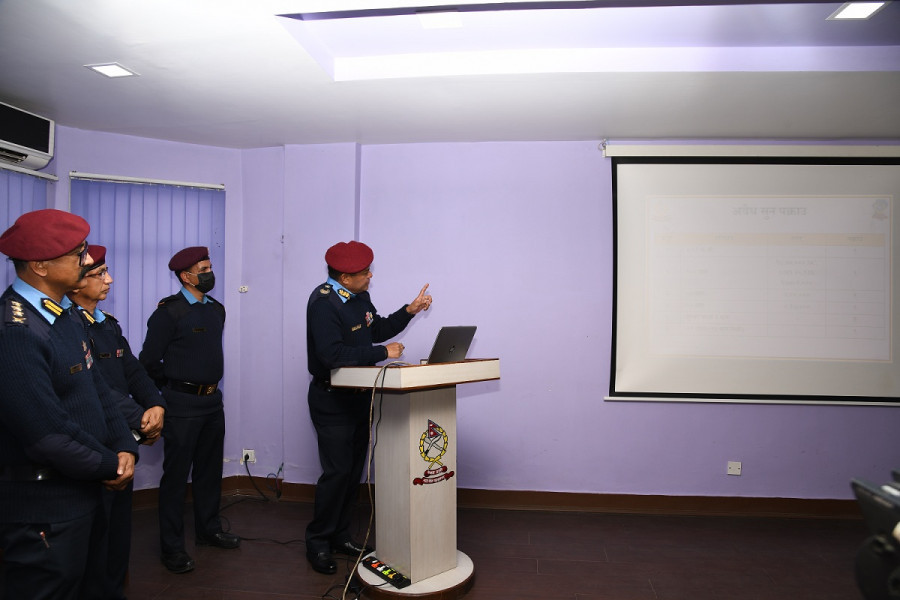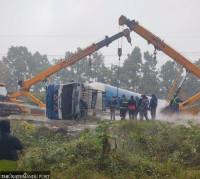National
Police tend to make public suspects too quickly and that’s wrong, experts say
The practice came to light once again when four people were paraded without ascertaining what they possessed was actually uranium, a material used for making nuclear bombs.
Shuvam Dhungana
Police on March 11 arrested four people for allegedly trying to sell what they called a highly radioactive material.
The arrest was made by the personnel deployed from the Metropolitan Police Office Ranipokhari “based on a tip-off”. The police office quickly disseminated information to the media, with full details of the arrestees—names and their addresses. Police also provided the arrestees’ photographs.
Police said that the four persons were arrested from Boudha as they were trying to sell 2.5 kg uranium. Various media outlets disseminated reports, some even suggesting the worth of the material at the current price, which stands in billions of rupees.
“We were informed that some people were trying to sell uranium after which our team raided the house of one of the arrestees at Boudha and arrested her and three others,” Senior Superintendent Sushil Singh Rathour, spokesperson for the Metropolitan Police Office, Ranipokhari, told the Post.
Police claimed the seized material was uranium-238, an isotope of uranium.
However, an official at the National Academy of Science and Technology told the Post that the material seized by police was found to have traces of radioactive material but it could not be ascertained if that was any of the isotopes of uranium.
After producing the arrestees before the District Administration Office in Kathmandu, police had taken them into five-day judicial custody.
The chain of events may look like a normal police investigation process, but experts on judicial matters and former police officials find fault with it.
According to lawyers, making information and photos of suspects public through the media without a court finding them guilty is violation of people’s right to privacy.
“It’s the court that decides whether someone is guilty or not,” said Balram Prasad Raut, an assistant professor at Nepal Law Campus, who holds a doctorate degree in international human rights law.
What the police did in the case of four people arrested for “possessing uranium-238”, however, is not an anomaly.
Nepal’s police have a tendency of parading even small-time criminals at police offices or releasing press statements with details of the arrestees with their full identities including photos.
While maintaining peace and security and controlling crimes are the police department’s prime responsibilities, the law enforcement agency must be careful while disseminating the information vis-a-vis timing and what details to be made public, experts say. What if the arrestees are pronounced not guilty by the court of law, they ask.
Raut says police can at least wait until a chargesheet is filed.
Former police officials told the Post that oftentimes police want to tell the people through the media about the arrests just to show “how efficient they are.”
“Not all, but some police officials have a tendency to do such publicity stunts which they believe will help them in getting promotions,” said Hemanta Malla, a former deputy inspector general. “Such practices of disseminating information and quickly making public the arrestees with their full details are wrong.”
The case of those arrested for “possessing uranium” by now has turned out to be a wild story, in which police officials’ imagination seems to have worked more than what the truth is.
According to police, one of the arrestees’ father-in-law used to work at a mine in India many years ago. Her father-in-law who is 86 years old currently resides in the United States of America. Police said the “high-value” material had been at the arrestee's house for years and that she, along with three of her acquaintances, was trying to sell it.
When police sent the details of those arrested to the media saying they were trying to sell uranium-238, the Nepal Academy of Science and Technology was yet to ascertain if the material actually was what the police claimed it to be.
Later the Nepal Academy of Science and Technology found that the material did have traces of uranium-238 but it could not ascertain the quantity.
“From the technology and manpower we have, we could only say that the sample which the police brought had the presence of uranium-238. But we don’t have the technology to determine the quantity,” Suresh Kumar Dhungel, spokesperson for the Nepal Academy of Science and Technology, told the Post. “Police should send the confiscated material to the Department of Mines and Geology for confirmation as they could have the technology.”
Uranium-238 is the most common isotope of uranium found in nature and accounts for more than 99 percent of all naturally occurring uranium.
This form of uranium, though highly radioactive, is said to be of no use for making nuclear weapons.
Uranium is used in nuclear plants and nuclear weapons but there is no agency, technology or centre in Nepal where this material can be used, according to Dhungel.
But the form of uranium used in nuclear plants and nuclear weapons is uranium-235 and not uranium-238, which the police claim to have seized from the arrestees. Uranium-235 makes up about 0.72 percent of natural uranium.
Unlike uranium-238, the predominant form of uranium found in nature, uranium-235 is fissile, which means it can sustain a fission chain reaction.
To use uranium-238 in nuclear weapons, it must be enriched.
With the Nepal Academy of Science and Technology unable to confirm the amount of uranium-238 present in the confiscated material, it was not immediately clear if it could be made even into a dirty bomb.
Those arrested now are facing the charges under the Explosive Materials Act-1963.
Malla, the former police official, says press conferences to make public details about crime and suspects should be held after concluding the investigation.
“If information is made public in a haste, there is even the risk of investigation getting affected,” Malla told the Post.
According to experts, at times police tend to parade the suspects also when they are under pressure and to assert that they indeed are pursuing a particular case in earnest. But a hasty decision to parade a suspect can backfire, they say.
In 2018, a 13-year-old girl was found dead in Kanchanpur. The case later was known as Nirmala Pant rape and murder. Police had made a spectacular bungling from the very start and there was a public outcry over the law enforcement agency’s failure to investigate the case properly. The case drew a lot of attention.
On August 18 that year, police made public a man who they said had committed the crime. Police said the alleged perpetrator was intellectually challenged.
The District Attorney’s Office later released the man after DNA samples collected from Nirmala’s body did not match the man’s DNA.
Police have not been able to solve the case yet, as no one has been arrested.
In February this year, police made public a teenager for raping and murdering a 17-year-old girl in Baitadi. Despite the suspect being a minor, police made public his details, something not allowed by the law of the land.
There was a public outcry over the Baitadi case also, as the public feared police could make yet another fiasco, just like in the case of Nirmala.
Police have yet to conclude the investigation.
In 2015, police arrested five football players, including national team skipper Sagar Thapa, for their alleged involvement in match-fixing. A charge-sheet was filed against the footballers, seeking life sentences under charges of subversion. However, on June 7, 2018, the footballers were acquitted by the special court due to a lack of evidence.
Apart from these cases, police often hastily make public those people who are suspected of committing petty crimes and release their photos and details.
“Police are meant to enforce the law. This does not mean they are above the law,” said Raut, the assistant professor at the law campus. “Law enforcement officials must understand the fact that not every accused person is criminal until proven guilty and it’s the court that decides if anyone is indeed guilty of a crime.”
According to Raut, making public all the details of every suspect itself is an unlawful act.
Even during arrests, police often fail to abide by the due legal procedure, say experts.
There are two ways to make an arrest: a normal process and an urgent process, he said.
“In the normal process, police officers need to take permission from the court for an arrest while in an urgent condition, police can arrest the person first and seek permission from the court later to keep the suspect in custody for investigation,” said Raut. “But that does not mean police have to disseminate information to the media about the arrestees. They can wait until the investigation concludes.”
Section 17 of the Privacy Act, 2018 states under “Not to make the person under investigation public” that “until a chargesheet has been filed in the concerned body regarding the offence of which any person under investigation in accordance with the law has been accused, the authorised official shall not make him or her public in any manner.”
It, however, does not bar the authorised official from “publishing the name of such accused person and details or information of the charge against him or her.”
Experts say more often than not, police officials tend to employ the disclaimer to make public the details of the accused even when that is not necessary. What is even more damaging is, according to them, that police officials tend to violate the presumption of innocence. Suspects are often presented as though they are guilty.
Senior Superintendent of Police Basanta Bahadur Kunwar, spokesperson for the Nepal Police said, police usually publish the names of the suspect once they find the involvement of the person in a particular crime.
“During investigation, only when police find enough evidence, do they publish personal information of the arrestee,” said Kunwar. “Even in the uranium case, police published the suspects to the media as they were trying to sell unprocessed uranium-238.”
According to advocate Tilak Parajuli, who specialises in criminal law, in this particular case, the police, however, bungled.
“If police catch someone red-handed with illegal items and the person cannot provide a valid reason for possessing it, it could be taken as substantial evidence and police can make public the information about the arrestee,” Parajuli told the Post. “In the uranium case, however, police hurriedly made the accused public without even confirming that the confiscated material actually was uranium-238.”




 12.12°C Kathmandu
12.12°C Kathmandu













%20(1).jpg&w=300&height=200)

